Mike Phillips
Active member
- Dec 5, 2022
- 51,004
- 6
3 - Types of Water Spots - Type I, Type II and Type III
Water Spots are more complex than most people assume because there are different types of water spots. Some water spots are merely mineral deposits on the surface left behind after water with minerals has evaporated off the surface. These deposits can often be washed off the paint using a quality car wash soap.
Sometimes these deposits can also leave an imprint in the paint in the perimeter of the spot and in these cases the imprint must be removed using a compound or paint cleaner as it's a defect in the paint, not simply a deposit on the paint. Some sources of water, be it rain with air-borne pollution mixed-in, or sprinkler water from a city water supply or well water, can have corrosive enough elements in it that it will actually eat into or etch the paint leaving a depression or crater in the paint where the water dwelled or dried.
A Type II water spot can only be removed by leveling the surrounding paint by hand or machine with some type of abrasive compound or paint cleaner.
Type III Water Spots are primarily a stain in the paint which looks like fading where water pooled and then dwelled for some measure of time. This primarily happens to single stage paints which tend to be more porous and thus will absorb water into itself. If Type III Water Spots are limited to only the upper surface of the paint then they can be removed by abrading the paint by hand or machine with a compound or polish.
Before attempting to remove water spots it is important to first diagnose which type of water spot is affecting your car's paint.
Type I Water Spots
These are Mineral Deposits or what people commonly call "Hard Water Spots". It's the minerals in water that people are referring to when they use the word "hard" in the term "Hard Water Spots.
Type I Water Spots are primarily a mineral or dirt deposit laying on the surface of paint. Type I Water Spots can be the results of minerals suspended in city water or well water that are left behind after the water evaporates off the finish. This can happen by washing a car but not drying the water off the paint or if a sprinkler goes off next to the car covering the car with water drop that are not dried off the paint.
Type I Water Spots can also be dirt or pollution particles left behind after water from rain or inclement weather evaporates of the finish. Type I Water Spots can also be Type II Water Spots in that the water can leave both a deposit on the surface and an etching in the finish.
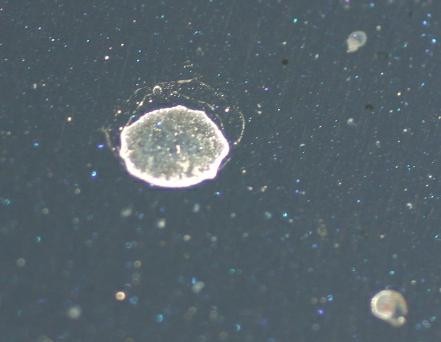
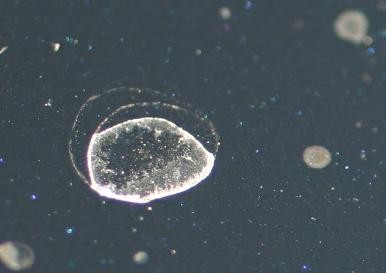
More Hard Water Spots or Mineral Deposits Caused by a Sprinkler


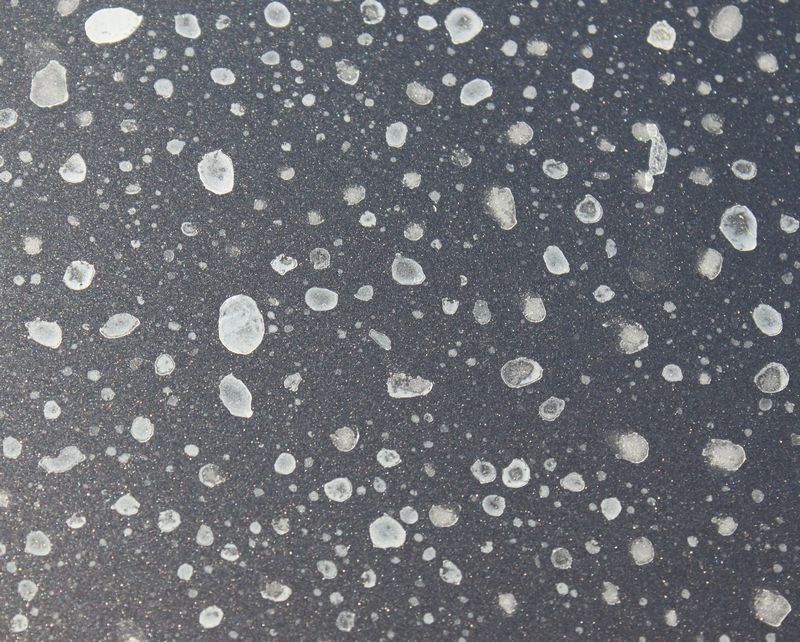


When following the approach of using the least aggressive product to get the job done, the first thing you want to do is to see if you can either wipe the sprinkler water spots off or wash the sprinkler water spots off. Since this car was recently washed and waxed and it's kept inside a garage when not being driven, we're going to try to wipe them off using a spray detailer with a clean, plush microfiber towel.
When removing fresh water spots, use your spray detailer heavy, or wet. Using a product heavy or wet means using extra product, more than you might normally use. The reason for his is you want lots of lubrication on the surface to help prevent any potential scratching or marring of the finish as you're wiping.
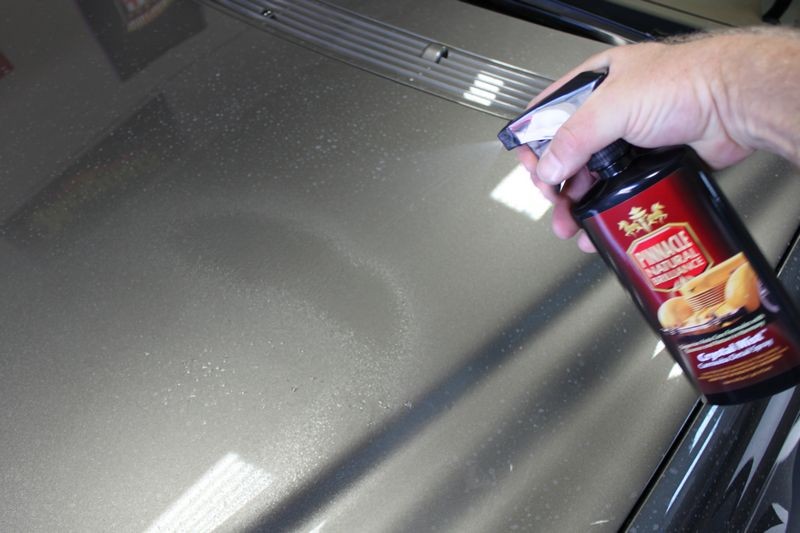
Remember, always fold your microfiber towels 4 ways to give you 8 wiping sides with plenty of cushion to spread out the pressure from your hand and wipe the paint gently.
Start out by spreading the spray detailer around to one section and then flip or fold your microfiber towel to a fresh or clean portion to remove the residue and buff to a dry, high shine.
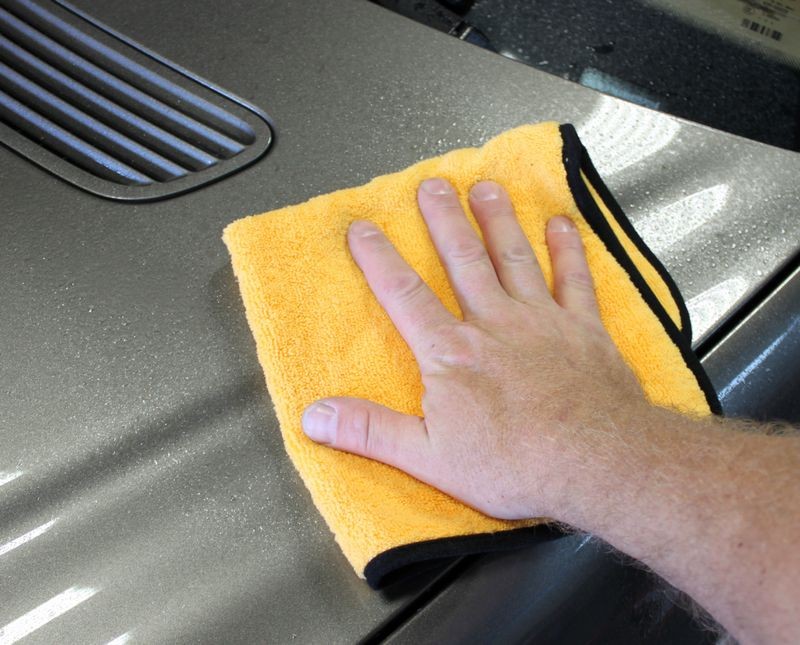
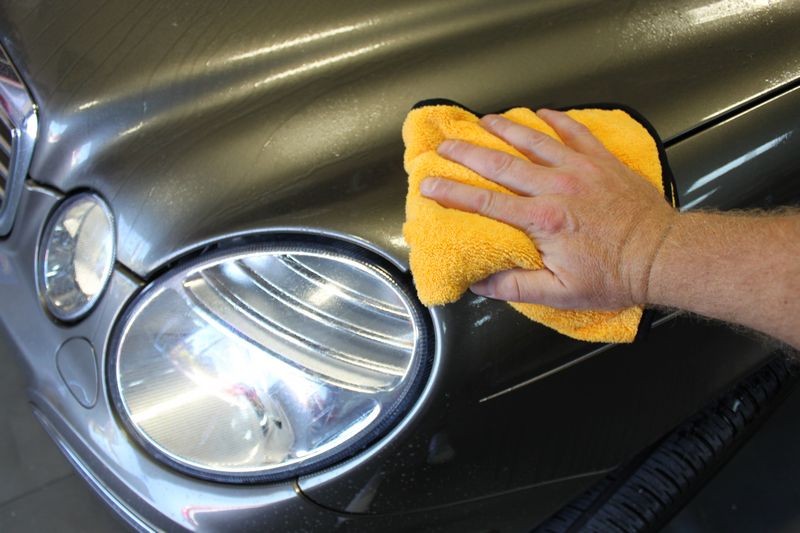
Luck is with us... the paint is safe as the Sprinkler Water Spots did not etching into the paint and using plenty of spray detailer and a clean plush microfiber towel left a scratch-free finish.

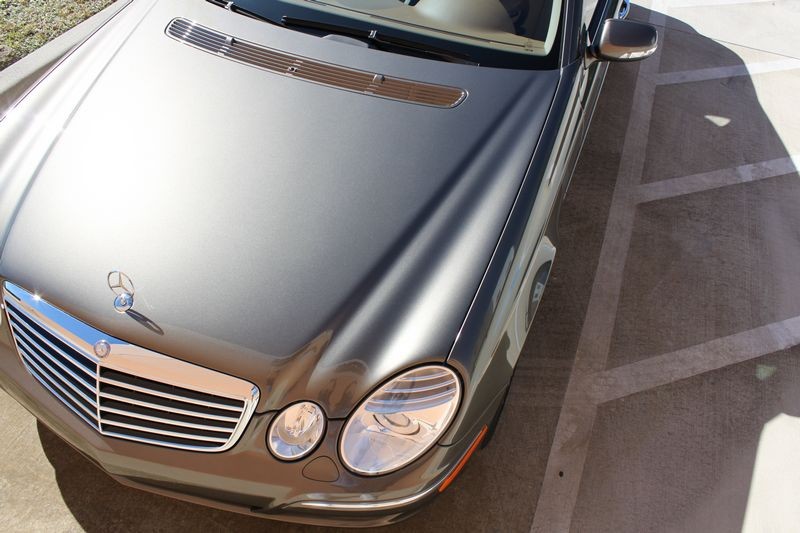
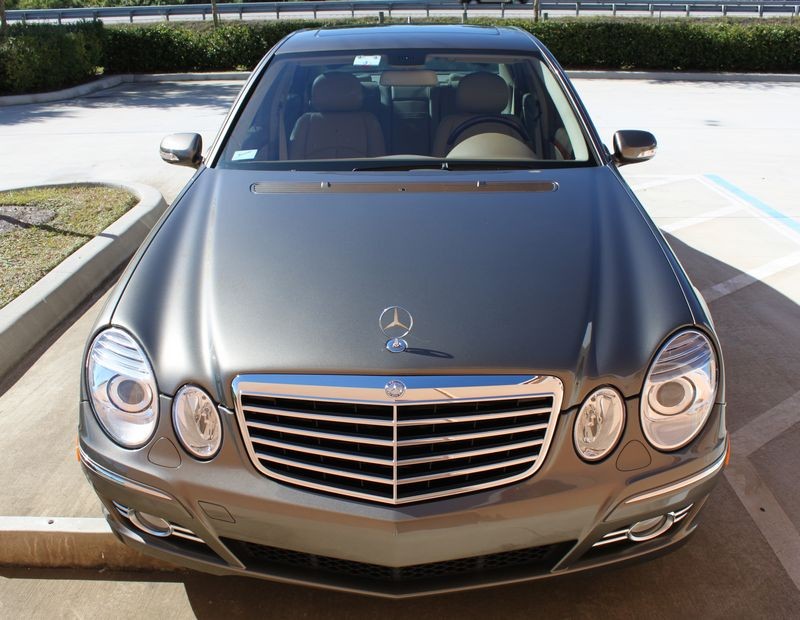
Type II Water Spots
Type II Water Spots are actual etchings or craters in the paint because something corrosive in a water source has landed on the paint and was not removed before a portion of the paint was eaten or dissolved by the corrosive substance.
I took this photo myself when I helped Alex Fong from Corvette Forum remove a zillion Type II Water Spots out of the clear coat finish on his Corvette.
Photo Courtesy of MeguiarsOnline.com
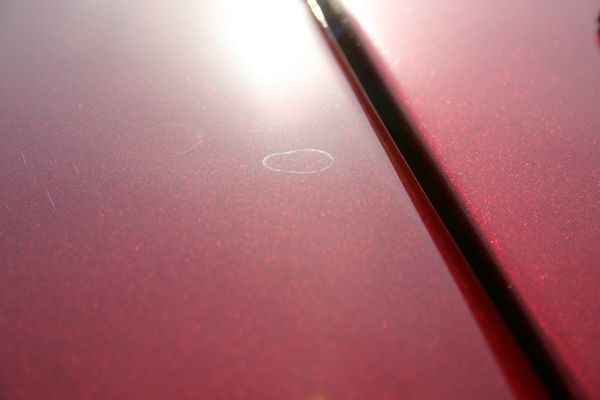
Here's a close-up of the same photo, if you look closely you can see the edges are angled downward as this is an actual etching "into" the clear paint.

Type I and Type II Water Spots
In some cases, a water spot can be both a Type I and a Type II, that is you can have Mineral Deposits on the sitting on top of the surface and the water could have been corrosive enough to also etch the paint leaving a crater in the paint where the spot formed.

Imprint Rings
These water spots look like they're established water spots, that is, every time it rains, or a sprinkler goes off, the water pools in the same place giving any corrosive substances repeated opportunity to etch into the paint.


Visually, I can tell the paint is likely etched in this instance but I won't know till I get the surface clean. The first step is to wash or wipe the finish, in this instance I'm going to repeat wiping process I used on the Mercedes-Benz with a spray detailer.


After wiping the paint clean, there are water spot imprints remaining in the paint.

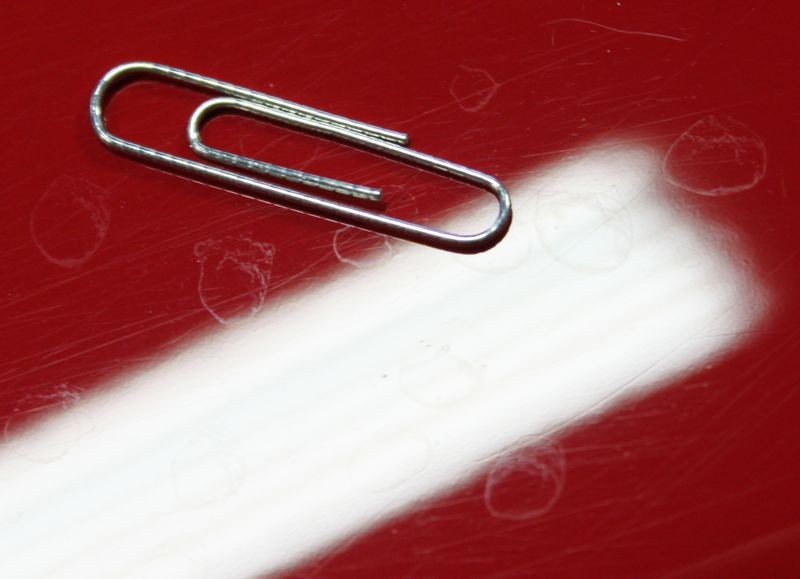

Type III Water Spots
Type III Water Spots are spots that look faded or dull and are found primarily found on single stage paints after a water source lands on and then pools on the paint and is usually left to dwell on the surface for some measure of time before it evaporates or is wiped-off the surface.
Modern clear coat paints tend to be harder and impermeable, that is non-porous, so liquids don't penetrated easily and thus stain spots tend to be topical, that is only affect the very upper surface and are easier and safer to remove with a compound or polish.
Older single stage paints tend to be soft and permeable, or porous, it's common for liquids to penetrate into the paint and stain the paint below the surface. Removing stains out of single stage paints can be risky because in order to remove the stains you have to abrade the paint and if the stains penetrated deep then you risk removing too much in an effort to try to remove them completely.
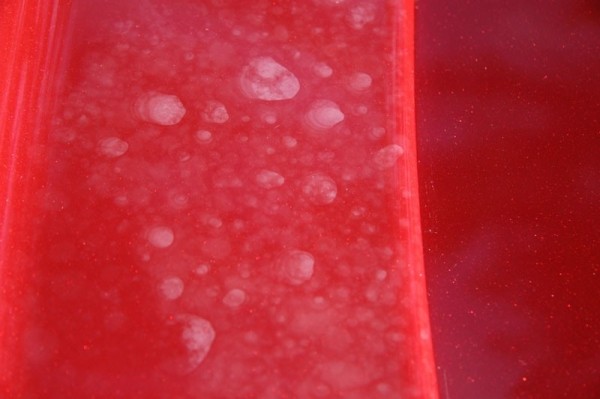
Water Spots are more complex than most people assume because there are different types of water spots. Some water spots are merely mineral deposits on the surface left behind after water with minerals has evaporated off the surface. These deposits can often be washed off the paint using a quality car wash soap.
Sometimes these deposits can also leave an imprint in the paint in the perimeter of the spot and in these cases the imprint must be removed using a compound or paint cleaner as it's a defect in the paint, not simply a deposit on the paint. Some sources of water, be it rain with air-borne pollution mixed-in, or sprinkler water from a city water supply or well water, can have corrosive enough elements in it that it will actually eat into or etch the paint leaving a depression or crater in the paint where the water dwelled or dried.
A Type II water spot can only be removed by leveling the surrounding paint by hand or machine with some type of abrasive compound or paint cleaner.
Type III Water Spots are primarily a stain in the paint which looks like fading where water pooled and then dwelled for some measure of time. This primarily happens to single stage paints which tend to be more porous and thus will absorb water into itself. If Type III Water Spots are limited to only the upper surface of the paint then they can be removed by abrading the paint by hand or machine with a compound or polish.
Before attempting to remove water spots it is important to first diagnose which type of water spot is affecting your car's paint.
Type I Water Spots
These are Mineral Deposits or what people commonly call "Hard Water Spots". It's the minerals in water that people are referring to when they use the word "hard" in the term "Hard Water Spots.
Type I Water Spots are primarily a mineral or dirt deposit laying on the surface of paint. Type I Water Spots can be the results of minerals suspended in city water or well water that are left behind after the water evaporates off the finish. This can happen by washing a car but not drying the water off the paint or if a sprinkler goes off next to the car covering the car with water drop that are not dried off the paint.
Type I Water Spots can also be dirt or pollution particles left behind after water from rain or inclement weather evaporates of the finish. Type I Water Spots can also be Type II Water Spots in that the water can leave both a deposit on the surface and an etching in the finish.


More Hard Water Spots or Mineral Deposits Caused by a Sprinkler





When following the approach of using the least aggressive product to get the job done, the first thing you want to do is to see if you can either wipe the sprinkler water spots off or wash the sprinkler water spots off. Since this car was recently washed and waxed and it's kept inside a garage when not being driven, we're going to try to wipe them off using a spray detailer with a clean, plush microfiber towel.
When removing fresh water spots, use your spray detailer heavy, or wet. Using a product heavy or wet means using extra product, more than you might normally use. The reason for his is you want lots of lubrication on the surface to help prevent any potential scratching or marring of the finish as you're wiping.

Remember, always fold your microfiber towels 4 ways to give you 8 wiping sides with plenty of cushion to spread out the pressure from your hand and wipe the paint gently.
Start out by spreading the spray detailer around to one section and then flip or fold your microfiber towel to a fresh or clean portion to remove the residue and buff to a dry, high shine.


Luck is with us... the paint is safe as the Sprinkler Water Spots did not etching into the paint and using plenty of spray detailer and a clean plush microfiber towel left a scratch-free finish.



Type II Water Spots
Type II Water Spots are actual etchings or craters in the paint because something corrosive in a water source has landed on the paint and was not removed before a portion of the paint was eaten or dissolved by the corrosive substance.
I took this photo myself when I helped Alex Fong from Corvette Forum remove a zillion Type II Water Spots out of the clear coat finish on his Corvette.
Photo Courtesy of MeguiarsOnline.com

Here's a close-up of the same photo, if you look closely you can see the edges are angled downward as this is an actual etching "into" the clear paint.

Type I and Type II Water Spots
In some cases, a water spot can be both a Type I and a Type II, that is you can have Mineral Deposits on the sitting on top of the surface and the water could have been corrosive enough to also etch the paint leaving a crater in the paint where the spot formed.

Imprint Rings
These water spots look like they're established water spots, that is, every time it rains, or a sprinkler goes off, the water pools in the same place giving any corrosive substances repeated opportunity to etch into the paint.


Visually, I can tell the paint is likely etched in this instance but I won't know till I get the surface clean. The first step is to wash or wipe the finish, in this instance I'm going to repeat wiping process I used on the Mercedes-Benz with a spray detailer.


After wiping the paint clean, there are water spot imprints remaining in the paint.



Type III Water Spots
Type III Water Spots are spots that look faded or dull and are found primarily found on single stage paints after a water source lands on and then pools on the paint and is usually left to dwell on the surface for some measure of time before it evaporates or is wiped-off the surface.
Modern clear coat paints tend to be harder and impermeable, that is non-porous, so liquids don't penetrated easily and thus stain spots tend to be topical, that is only affect the very upper surface and are easier and safer to remove with a compound or polish.
Older single stage paints tend to be soft and permeable, or porous, it's common for liquids to penetrate into the paint and stain the paint below the surface. Removing stains out of single stage paints can be risky because in order to remove the stains you have to abrade the paint and if the stains penetrated deep then you risk removing too much in an effort to try to remove them completely.

